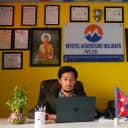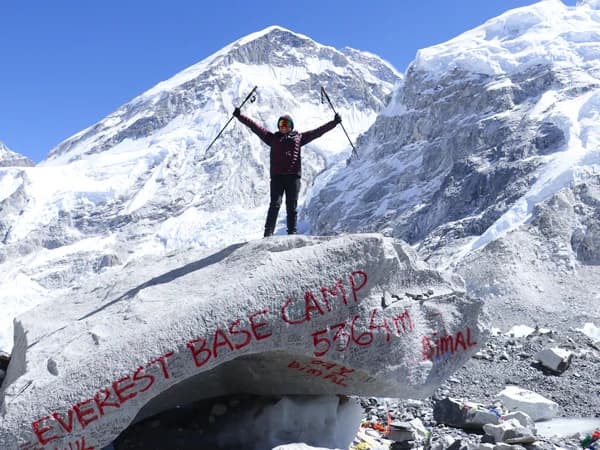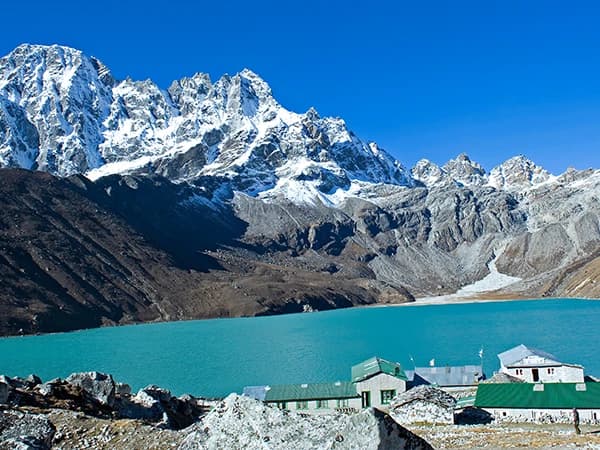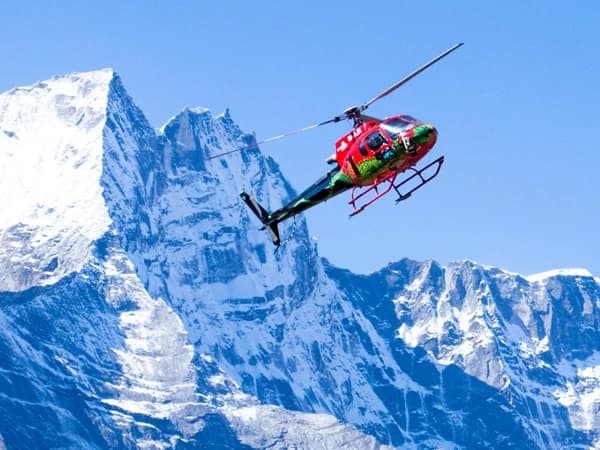Difficulty level of the trek
The Mount Everest View Trek difficulty level is graded as moderate. This trek is less challenging than other Everest region treks like the everest base camp trek. Therefore, even families and beginners with good fitness levels can go for the trek. During the Mount Everest View trek, you have to trek on the trails that are rocky, steep, and sometimes sloppy.
The total distance you will cover trekking is 42 kilometers in 4 days, with average walking hours up to 6 to 7 hours per day. These factors, along with the fitness level of the trekker, define the actual difficulty level of the trek.
Best time to go for the trek
The best time to go for the short Everest View trek is during March to May and September to early December. The rainfall is minimal, the weather conditions are stable, and the skies are clear, making the weather conditions favorable for trekking.
During the months of March, April, and May, the wildflowers, including rhododendron blossoms, make the landscapes stunning. Also, months like September to early December are called festival months when festivals like dashain, tihar, and chhat and so on occur.
Besides, these months are peak trekking season. Therefore, the overall Everest View trekking cost is high as compared to other seasons. You can try during the seasons, like the monsoon and winter seasons, with proper precautions and preparations.
Accommodation and Food Options
During the Everest View trekking, you will get a variety of accommodation options ranging from simple basic rooms to luxury hotels. While in Kathmandu, you will get the options of luxurious three-star or five-star hotels.
In places like Namche Bazaar and Khumjung, you will get the luxury options. For example, Yeti Mountain Home Lodge in Namche Bazaar and everest view hotel in Khumjung.
The average expenses can vary. For example, the hotel Everest View costs range from $320 to $3,275 per person per night, depending on the type of room. In this cost, you will get comfortable beds, Wi-Fi, dining facilities, attached bathrooms, and so on.
Next, the food options during the Everest View hotel trek vary from teahouses to lodges. In Kathmandu, you will have diverse options ranging from traditional Nepali dishes to international cuisine.
On the trek, you will have food options like fried rice, pizza, pasta, noodles (Thukpa), momos (Nepalese dumplings), oatmeal, Sherpa stew, Dal Bhat, sandwiches, porridge, omelets, Tibetan bread, and so on.
Toilet and shower facilities
The toilets in teahouses in Phakding feature Western-style flush toilets. There may or may not be attached bathrooms. In Namche Bazaar lodges and hotels, you can get attached toilets with modern flushing systems. In addition, in the Everest View hotel, you will get rooms with attached bathrooms featuring Western-style toilets.
During the Everest Panorama View Trek, most of the teahouses in Phakding and Namche Bazar offer hot showers for a small fee. In the Everest View hotel, you will get hot shower facilities included in the room amenities. Most of the hot shower facilities are solar powered, so the weather conditions may affect their availability.
Telephone, Internet, and Electricity
If you buy the local network provider’s SIM card, then you will be able to call anyone through your cellphone during the Everest View short trek. There is 2G service in Phakding, 3G in Namche Bazaar, and 4G in the Everest View hotel area.
For the fast internet, there are wifi-services available in the lodge you are staying at too. Or you can buy everest link wifi packages. For charging, the Phakding teahouses, Namche lodges and Everest View hotel offer the charging facility for free.
Weather and temperature
The weather and temperatures can vary according to the altitude levels. At the lower altitudes, like Lukla, the temperatures can be mild. While in the higher altitude areas, like namche bazaar and Khunde or Khumjung, the temperatures can be cooler. Below is the seasonal breakdown of the weather and temperatures in the trekking areas of the Everest View trekking trail.
- During the spring season, the average daytime temperature ranges from 7°C to 15°C, while the nighttime temperatures can drop below freezing temperatures. The overall weather conditions are stable, making them perfect for the treks in the Everest region.
- In the autumn season, the daytime temperatures can go up to 12°C, and the nighttime temperature can drop below freezing temperatures. This season is characterized by the stable weather conditions and excellent visibility.
- The winter season comes with cold weather conditions. During this season, the daytime temperatures can float around freezing temperatures, while at night, it can drop below freezing. There is a chance of snowfall.
- The average temperature during the summer season is 15°C, and the average nighttime temperature is 2°C. The weather conditions are stable, with a high chance of heavy rainfall.
For the real time info, you can also use the weather forecast apps.
Permits required for the trek
The permits required for the Everest View short trek are the Sagarmatha National Park Entry Permit and the Khumbu Pasang Lhamu Rural Municipality Permit. You can obtain both permits at the nepal tourism board office in Kathmandu, in Lukla, and in Monjo.
The cost of the Sagarmatha National Park entry permit is NPR 3,000 for foreign nationals, NPR 1,500 for SAARC nationals, and NPR 100 for Nepali citizens. In addition, the Khumbu Pasang Lhamu rural municipality permit costs NPR 2,000 for the first four weeks and increases to NPR 2,500 after that.
If you want to fly the drones in this region, you will need a drone permit. Learn more about the drone laws in Nepal from the link.
Note: The expenses of the permit are included in the Mount Everest View trek cost inclusions.
Flight transportation and luggage
When going on the Everest View Trek for 8 days, you should be serious about flight prebookings, transportation planning, and luggage packing. Below is some useful information regarding flight transportation and luggage for the trek.
- International and internal flights: If you are traveling from abroad, it requires a visa and passport. Visa on arrival is only for some countries. Make sure to check your eligibility for the visa on arrival before booking the flight. You can carry 23 kg, including your luggage and hand baggage, on your international flight. The flight to Lukla allows only 15 kg of luggage. For extra weight of the duffel bag or daypack, you have to pay an extra amount of money.
- Luggage needed for the trek: A duffel bag of 80 L capacity and a 50-65 L backpack are required for carrying essential equipment. Typically, the porter will carry the duffel bag while you are responsible for carrying your own backpack. You may need a small, 20–30-liter day backpack to carry your essentials during the day’s hike.
Altitude sickness issues and acclimatization
Altitude sickness is a serious concern for the trekkers who are planning to go for the Everest Panorama trekking. The maximum altitude level reached during the trek is about 3,880 meters (12,730 feet). At this level, the body struggles to adapt to the lower oxygen levels.
If the body fails to adapt to the lower oxygen level, then symptoms like headache, nausea, vomiting, dizziness, lightheadedness, fatigue and weakness, shortness of breath, disturbed sleep and so on can be seen on the trekker's body. It is called altitude sickness symptoms.
To prevent these symptoms, you need to apply certain strategies. For example, you should ascend gradually, drink plenty of fluids, incorporate rest days into your Mount Everest view trek itinerary, have balanced diet foods, avoid overexertion, climb high and sleep low, and so on. If symptoms persist, descend immediately.
Customize itineraries and trip extensions.
The Mount Everest View Trek itinerary can be customized, and trips can be extended further based on your preferences and fitness level. Some of the customized itineraries are given below:
The customization of the Mount Everest View Trek itinerary means extra days for acclimatization days, side trips to nearby landmarks, and so on. The trip extensions include visiting the nearby villages, monasteries, or viewpoints, or even extending your trek to include other destinations.
As a mystic adventure representative, we will organize, customize, and extend your trekking journey through the Himalayas.
Group leader and crew in the trek
Our certified trekking guide will assist you during your trekking journey. We also provide sherpa staff for carrying your heavy baggage, and one porter will carry the luggage of two guests.
Tips to make the journey successful
- Choose the best season for the trekking, as not all the seasons may give you the best experiences.
- Invest in high-quality, broken-in hiking boots.
- Dress in layers to manage the temperature fluctuations.
- Take regular breaks to rest and hydrate.
- Always listen to your guide and follow them.
- Sleep early each night to recover from the daily exertion.
- Study the trekking map before the trip so you can be prepared for the possible challenges.
- Carry cash to use on the way, as there are no ATMs in Phakding and Khumjung, and the atm in the namche bazaar may run out of cash sometimes.
- Carry a Nepali SIM card to use cellular data on the way.
- Respect the leave no trace principle and carry your garbage yourself and dispose of it in dustbins only.
- Pack some snacks in your backpack to maintain the energy level throughout the trek.
- Carry extra batteries and a power bank to avoid running out of charge on mobile phones.
- You can tip any amount you like to the crew members after the Everest View luxury heli trek. To give you a general idea, this is what we recommend: USD 150 to the porter & guide, USD 5 to the tour guide, and USD 2 to the driver.
- Always say namaste to the locals, touching both palms and bending a little.

















